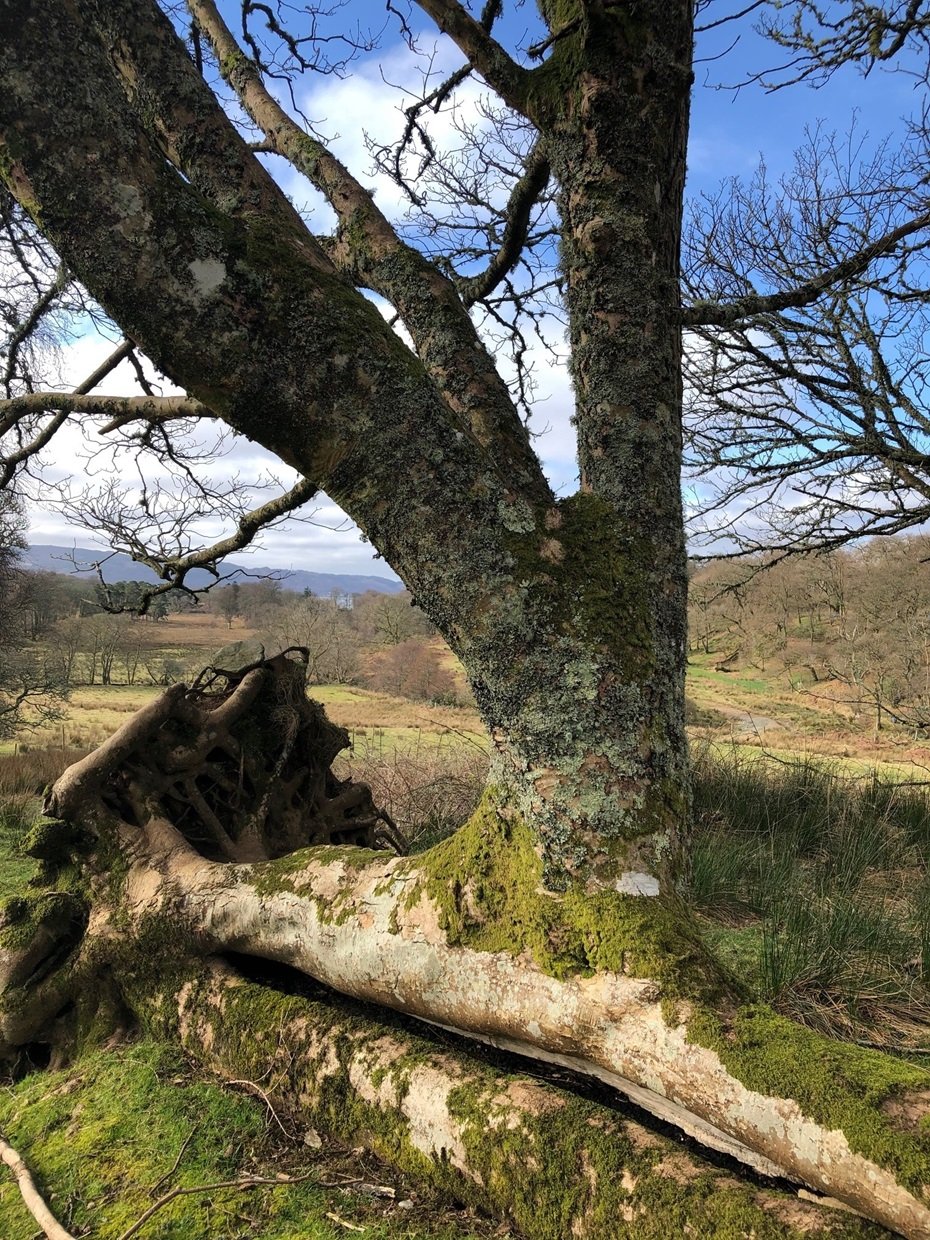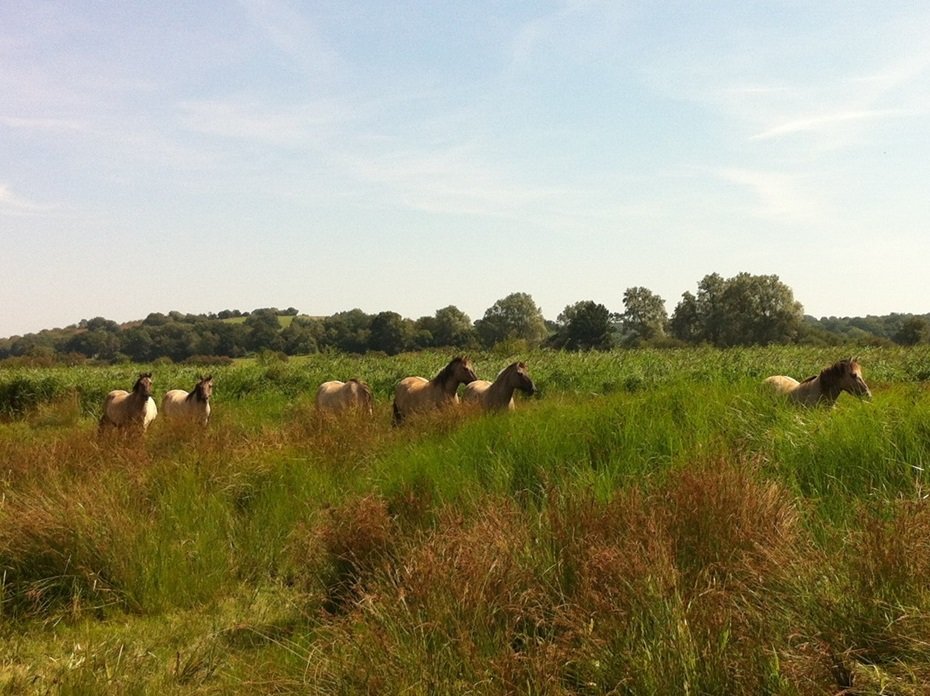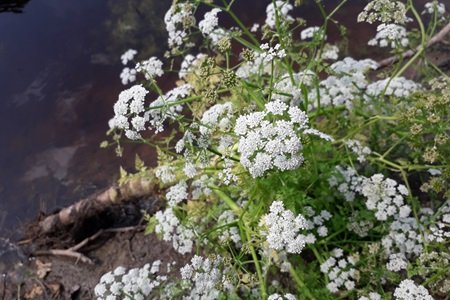Fran's Blogs
Unfeasible Trees, Triumphant Trees, and Trees that Try

Have you ever stopped and wondered at the tenacity of a tree which has been toppled in a storm – root ball flailing - and yet along its trunk, fifteen new young trees are surging their way towards the light? It’s a beautiful testament to the resilience of life.
You may well not have seen one. Not many of us get the chance because they are mostly chopped for firewood, whilst most other trees are encouraged to be mono stemmed to create harvestable timber. In woodlands managed for forestry, fallen trees are systematically cleared away and living trees expressly have their lower branches ‘cleaned’ to make sure that they grow tall and straight. All the trees that we plant in plastic tree tubes have no choice but to grow upwards in a straight line for the first several years of their lives.
Because it is missing from our memories, we don’t think twice about how entangled and interesting a woodland might once have been. In many woodlands its quite a challenge to find a tree which is wonky, or wibbly or just downright wild. Personally I love these trees – trees which have, against all the odds of animals browsing, people chopping, winds blowing, squirrels gnawing, and all sorts of other things assailing them - found a way to survive, and thrive, and live to old age, albeit with a few scars and one or two limbs missing.
There is a quirky, irreverent and sculpturesque quality to them which appeases my eye and my soul when set against a landscape of neatness and tidiness. And each one of these unfeasible trees has a story to tell about how it came to be so sculpted – sometimes we may be able to hear that story, and other stories are lost in the mists of time. Was this tree once felled by a beaver before they became extinct in Britain? Was it planted as a seed in a burial chamber which grew around its obstructions towards the light bursting forth into the fresh air? Or did it cling to a rocky crevice until the rocks fell and threw it tumbling downwards into a previously unforeseen abode?
These trees are wonderful to me. They have grown belligerently, as they wish, for decades if not centuries. Some grow at right angles where once they were caught under another tree branch, other trees ‘kiss’ and become enmeshed with each other, with separate species merging into one tree as bark swallows bark. They mark for me, places where the human hand has still not quite touched everything, whilst simultaneously creating a myriad of little niches for a multitude of species which would otherwise not be able to survive on our neater trees.
My mission, should I choose to accept it, is to bring these Transformational Trees back into our woodlands and landscapes. To create wilder spaces where we relinquish our need for orderliness, and allow nature to be as free form and creative as she wishes to be. If it works, then some time in the future the trees that you might see will be breathtaking in their wilful abandonment of human order and refreshing in their incredibly natural ‘tree-ness’.
Image: copyright Susie @ the_gardeners_cottage
The subtle making of a wild place

The natural world is a subtle place, pulsing with intricacies and symbioses - often ignored or misunderstood by us. These days most of us (even the conservationists!) are far removed from our own symbiotic relationship with nature – be it our gut flora or our place as a hyper keystone species in a natural food pyramid. Our understanding of what it means to be natural or wild is often more of a concept than a reality.Important scientific discoveries help us to understand singular aspects of our unimaginably diverse and complex environment, and the intricate relationships therein. It can never fully help us to understand the complete wildness of nature however – and we should never expect to be able to. But there is a deeper ‘knowing’ of a thing. A recognition of something, species to species, which occasionally pushes through our instincts into our consciousness – and this knowing is an incredible tool if we can harness it.
At Sussex Wildlife Trust, we spend a lot of time helping people to regenerate nature, make it wilder … more natural, but what does that really mean? It’s the age old idea that if a tree falls, or a wild place evolves – do we see it, smell it, touch it, hear it? – and what does it look like? Even as a seasoned ecologist is it difficult to pinpoint the subtleties of what makes a place essentially natural or wild.
Wildness can be an event – a flood, a storm, a hurricane, a volcano, a blizzard, or a lightning strike which tears apart and re-forms our landscapes. It is also the calm before, and after the storm – there is often more calm than storm, but we tend to remember the stormy part, because this is the part which creates rapid change, and we are often powerless in the face of it.
Wildness is change, evolution, constant transformation from one form to another – the slow wearing of beach pebbles, the changing of a season, or the migration of a bird. Humans as a species often resist change, and yet change brings us some of the most incredible transformations.
Wildness is life – pulsing, abundant, irrepressible, joyful life. But it is also death – and death in a sense that there is a renewal and a furnishing of life in death. Fungi, insects and bacteria which break down our dead things and turn them back into life again. We often resist this part too, forgetting how essential it is to the circle of life.
Wildness is often about a sense of calm, when fully, beautifully immersed in nature. And also the sense of panic of being unsure, out of one’s depth, fearful of unknown wild creatures and the natural elements which are out there – another resistance here perhaps.
Wildness is an experience. It is sensory. It is sights, sounds, smells, sensations, textures and shapes in a myriad of dazzling forms which assault the senses. It is a symphony that we have long since forgotten the tune to, but which we occasionally hear the odd phrase or bar of, as the breeze hums its story to us over a summer meadow. Wildness is walking barefoot on snow – grass – sand - nettles. It is the experience of knowing that we have little control over wildness, but perhaps that is half the joy of it. It is the silence as much as the sound. Comfort as much as discomfort.
Wildness is both darkness and light – beyond light pollution to dazzling galaxies of stars set into the places that swallow light whole, or chasing a firefly through a garden. Stirring up the dark ocean at night to see the sparkle of the phosphorescent algae. Seething darkness, and glowing, skipping, bursting light. Dawn, dusk, midsummers day, midnight.
Wildness is both ancientness and newness. It is the bursting open of a bulb, a birth, or the seething megalith of an ancient tree dripping with lichens and other wild nature, and remembering histories we have long forgotten.
Wildness is temperature; heat & cold - everything from jangling icicles on trees to steaming mists after a midsummer rainstorm. It is the knowledge that these natural things are essential to sustain us, but that they can also kill us.
Wildness is ebb and flow, boom and bust, movement and stillness, inspiration and exasperation. But most of all it is instinct. An instinct that I hope we will start to remember, and to become more comfortable with. I hope that instinct will help us remember what wild nature truly is – piece by piece as we start helping nature to lead its own recovery.
Wildness is about how we feel about ourselves, and our connection with nature, and whether we choose to engage with it in delight, in safety, up close or in fear. Most important though, is to remember that we human beings are a part of wild nature. We are a species in a tumbling, abundant, naturally ordered mess of a world, and even if we can recognise that one fact, we may find it much easier to know nature and to know how to help it.
Published for Sussex Wildlife Trust in February 2020
Fran's Blogs
Words can inspire and help us to understand nature much better. Explore Fran's blogs. They are designed to help you to re-think your approach to our natural landscapes.
20 Tips on How to Wild
It can take time to learn how to allow nature more latitude to restore itself. Explore 20 simple actions that everyone can take to help make our land and seascapes wilder.
There are a few key principles that you can embrace:
- Accept change
- Venture into the unknown
- Be the change & lead by example
- Engage with imagination
- Relinquish control
- Share in your abundance Find out more...







